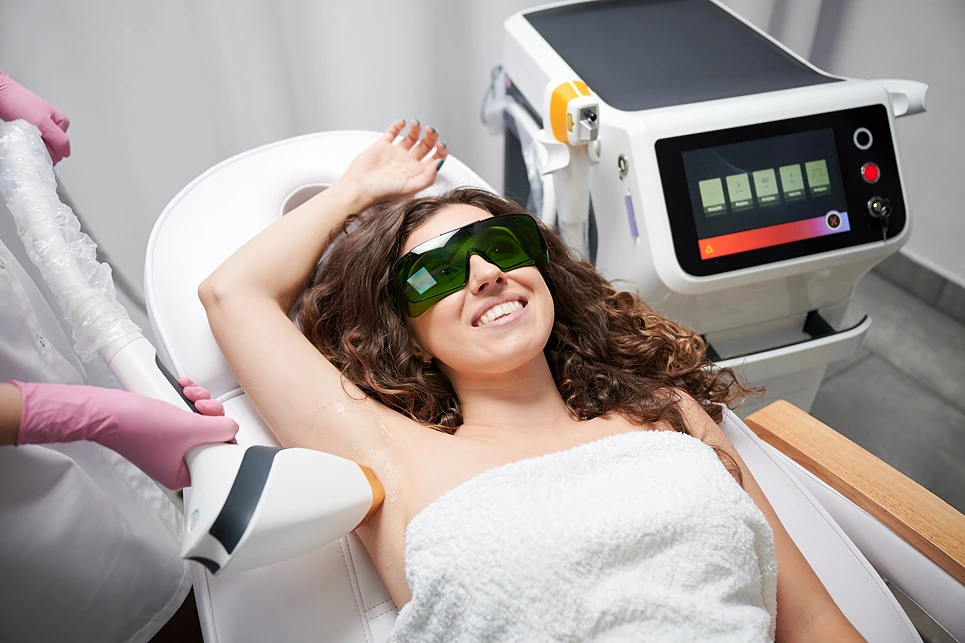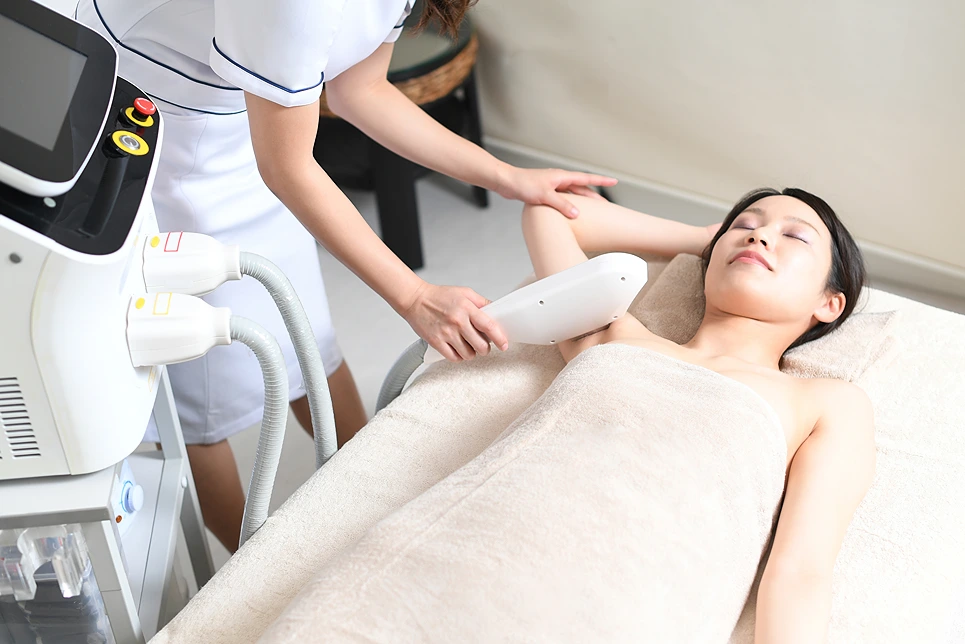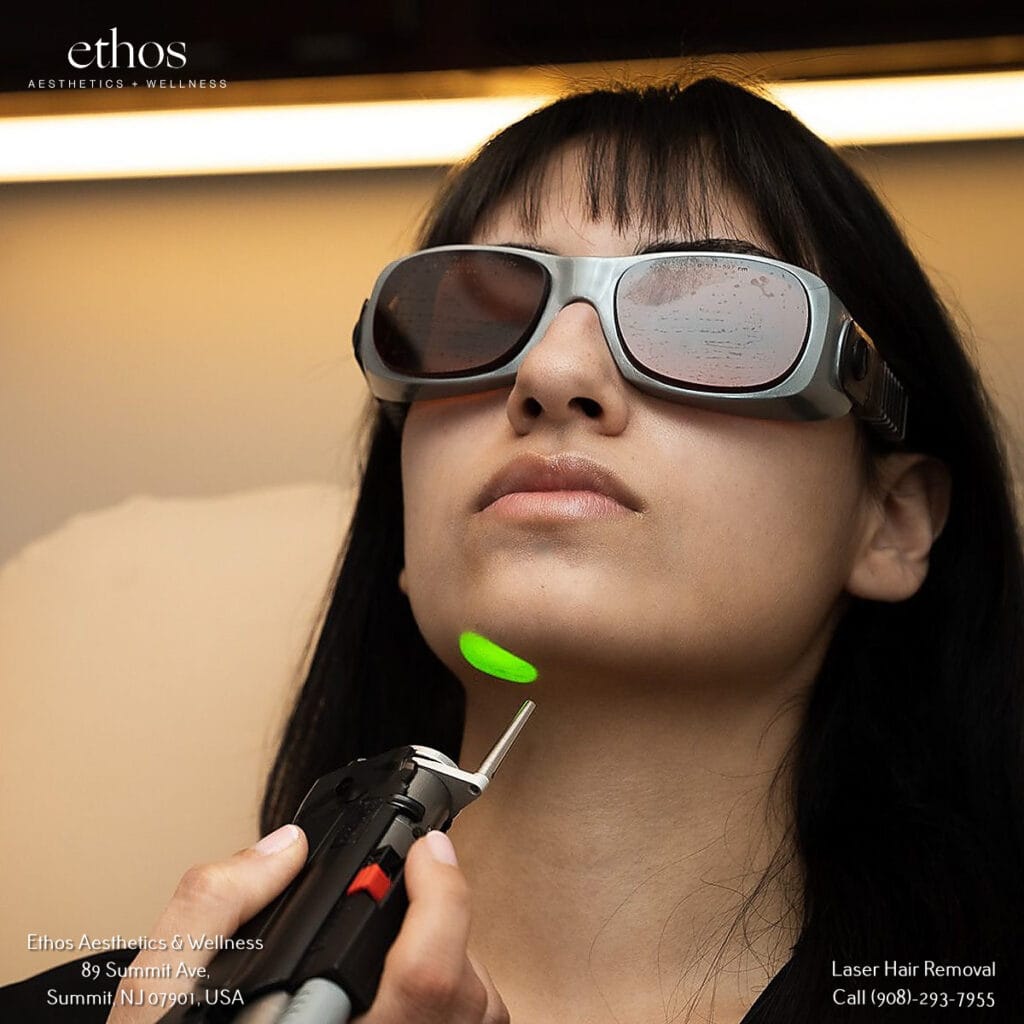Unwanted Hair? Your Skin Type Matters. Learn Why by Reading On.
Have you ever looked in the mirror and thought, “I wish my underarms, legs, or face were free of unwanted hair for good!” If so, laser hair removal may be right for you. But does your skin type fall into the suitable range? Not all complexions are ideal candidates.
We’re sharing expert tips on which lasers work best for which tones at Ethos Spa. You’ll learn how melanin levels, hair color, and sun habits impact results. Debunk hair removal myths based on ethnicity. Finally, discover proper skin prep and aftercare to prevent problems.
What Skin Types Are Suitable for Laser Hair Removal?

The best candidates for laser hair removal have naturally darker, coarser hair and fair skin that tans minimally, such as Fitzpatrick skin types I-III, as this allows optimal laser energy absorption to disable hair follicles without excess melanin blocking effects or risks.
Dark, Coarse Hair for Optimal Laser Absorption
The laser works by targeting melanin pigment in the hair follicles. Those with naturally darker, thicker hair tend to see the best results, as the laser energy is readily absorbed. Fine, light-colored hair may require multiple treatments before showing significant reduction.
Do you have dark leg or underarm hair you want gone for good? The laser hair removal we offer at Ethos Spa can be effective if the hair has an ideal texture and tone based on our patients’ experience.
Light Skin for Minimal Laser Blockage
On the other end of the spectrum, pale complexions allow for greater reflection of the laser beam. This enables more energy to penetrate below the skin’s surface to disable hair follicles.
Darker skin runs a higher risk of burns or post-inflammatory hyperpigmentation. Why? The extra melanin can absorb and block some of the incoming laser light, preventing it from reaching the target.
Minimally Tanning Skin Types I-III Are Most Suitable
According to Dr. Soni’s insights, Fitzpatrick skin types I through III tend to be ideal candidates. These phototypes range from very fair to light brown, and tan minimally when exposed to the sun’s UV rays.
Higher Skin Type Numbers Call for Specialized Lasers
For those with darker skin types IV through VI, achieving safe and satisfactory laser hair removal is possible with newer long-pulse lasers designed specifically for higher melanin levels.
Notably, the Soprano Titanium laser can safely treat all skin tones when properly calibrated. Lighter skin still shows greater hair reduction in the 45-48% range, while darker skin experiences approximately 40% reduction based on one clinical study.
Want Custom Laser for Your Complexion? Ethos Spa Specializes in All Skin Types. Book Now!
Which Laser Hair Removal Technology Is Best for Sensitive Skin Types?
For fair skin, alexandrite or diode lasers are recommended as gentler options, while Nd:YAG lasers are considered the safest for darker skin types; regardless of tone, consulting a dermatology laser professional to evaluate skin and select the optimal technology is advised.
We prepared this table to give you a good overview of the necessary information regarding various laser technologies and which skin type suits them best.
| Skin Type | Recommended Laser Technology | Reasoning |
| Fair to Medium (Fitzpatrick I-III) | Alexandrite laser | Gentler, less painful |
| Diode laser | Gentler, less painful | |
| IPL (e.g. Braun Silk-Expert Pro) | Budget option for lighter skin | |
| Darker (Fitzpatrick IV-VI) | Nd:YAG laser | Longer wavelength safer for darker skin |
| Diode laser | Can be effective when properly calibrated | |
| GentleMax Pro (Alexandrite + Nd:YAG) | Combines options for wider range of skin tones | |
| All Skin Types | Consult a dermatology laser professional | Can evaluate skin and select optimal technology |
| Avoid at-home devices | Less powerful, higher risks for darker skin |
Can People With Tanned Skin Receive Laser Hair Removal?
Freshly tanned or sunburned skin should not undergo laser hair removal according to Dr. Soni. Most experts recommend waiting at least 2-3 weeks after tanning or burns have healed before considering treatment.
The extra melanin present in tanned skin competes with hair follicles for absorption of the laser energy. This makes treatments less effective, often requiring more sessions to achieve the desired reduction.
Proper calibration of laser wavelength and settings by an expert is crucial for safe, optimal results on tan skin. Alexandrite 755nm or Nd:YAG 1064 nm lasers are common options.
Risks like burns, blistering, and skin discoloration are elevated with tanned skin, though a skilled provider can minimize complications through appropriate parameter adjustments.
It’s also wise to avoid additional sun exposure and tanning between treatments. This sensitizes skin and lowers receptiveness to the laser, while increasing the likelihood of side effects.
Pre-Treatment and Post-Treatment Care for Various Skin Types

Pre-treatment care includes avoiding sun exposure and trimming hair before lasers, while post-treatment care involves soothing with aloe vera gel, expecting temporary redness, allowing hairs to shed naturally, avoiding sun for a month, and following a dermatologist’s personalized aftercare based on skin tone.
Preventing Problems Before They Start
The key to minimizing laser risks? Sun protection. One month before your first laser session, be vigilant about avoiding UV exposure.
It’s also wise to trim or shave hair close to the skin a few days prior. Long hair above the surface absorbs some of the laser’s energy before it reaches the follicle. Getting a close shave beforehand enables the beam to penetrate more efficiently.
Post-Treatment TLC
Once you’ve made it through your laser session, the skin in the treated zone may have a temporary pink glow. Expect some redness and swelling immediately after, but this typically fades within hours.
Applying a cool compress or aloe vera gel can provide soothing relief during this initial recovery period. Over the next 7-14 days the zapped hairs will make their exit as they shed. No need to pull – be patient and let them fall out on their own time.
Here’s where sunscreen again plays a key role. For at least one month post-treatment, diligently protect treated skin from UV exposure and avoid tanning. This prevents unwanted darkening or discoloration as the skin recovers. Theodore Roosevelt had it right: “Speak softly and carry a big stick” – in this case, a bottle of SPF.
Debunking Myths About Laser Hair Removal and Skin Tone
Over the years, misconceptions have arisen about how skin color impacts laser hair removal results and safety. Let’s set the record straight on some common myths:
Myth 1: Laser hair removal only works on light skin tones.
False. While earlier laser technology was indeed limited in this regard, advances have now made it safe and effective for all skin types when performed properly. Lasers like the long-pulsed Nd:YAG use longer wavelengths designed specifically for darker pigmentation.
As long as there is contrast between hair and skin color, lasers can successfully reduce hair regardless of ethnicity.
Myth 2: Laser hair removal is a very painful procedure.
Most patients describe the sensation as comparable to a rubber band snapping on the skin. Modern laser systems use integrated cooling methods to greatly minimize discomfort during treatment. Lasers are much less painful than traditional hair removal methods like waxing.
Myth 3: You only need one laser session to remove hair permanently.
False. Since hair grows in cycles, multiple treatments are required over weeks or months to disable all follicles. Each laser session only affects actively growing hairs. Most patients need 4-6 spaced out sessions to achieve up to 80% long-term reduction.
Myth 4: Laser treatment can lead to skin discoloration.
There is a small risk of hypo- or hyperpigmentation with any laser procedure. However, choosing the optimal wavelength and settings customized for your skin type minimizes this risk significantly. Avoiding sun exposure before and after lasers also prevents burns or damage that may cause color changes.
Myth 5: Laser hair removal causes serious side effects like skin cancer or fertility issues.
No scientific evidence supports these alarming claims. Laser energy only penetrates deep enough to target hair follicles, without impacting internal organs. When performed properly by a trained professional, laser hair removal is a very safe, non-invasive cosmetic procedure.
Maintaining Laser Hair Removal Results on Darker Skin

According to Dr. Soni’s experience, patients with darker complexions may require additional effort to sustain laser hair removal results long-term:
- Using an intense pulsed light (IPL) device can be safer and more effective than traditional lasers for melanin-rich skin. IPL emits a broader spectrum of light that better targets hair.
- Undergoing 6-8 initial treatments spaced 4-6 weeks apart helps disable hairs in all growth phases. Expecting to need “maintenance” sessions every 4-6 months on an ongoing basis is advisable.
- Avoiding any sun exposure or tanning before and after lasers is critical to prevent hyperpigmentation and skin damage.
- Continued hair removal methods like shaving or waxing between sessions can eliminate any lingering hairs while stimulating further destruction of follicles.
- Applying broad spectrum sunscreen daily is key to protect treated areas from UV damage that may lead to discoloration.
Potential temporary side effects like hypo- or hyperpigmentation may occur, especially in darker tones. Choosing an optimal wavelength laser tailored for your skin type can greatly reduce risks.
Bare Your Body with Confidence via Ethos Spa’s Skin-Friendly Lasers. Let’s Discuss Your Options!
FAQs
Is laser hair removal effective for Indian skin?
Laser hair removal is effective and safe for Indian skin when performed properly using Nd:YAG or diode lasers, which bypass skin pigment to target hair follicles.
What are the best laser hair removal options for olive skin with dark hair?
The best laser hair removal options for olive skin with dark hair are Nd:YAG and diode lasers, which can differentiate between skin and hair pigment to effectively target hair follicles.
Can black skin safely be treated with laser hair removal?
Yes, black skin can be safely treated with laser hair removal using Nd:YAG or diode lasers, which are designed to work on darker skin tones by bypassing skin pigment.
What are the risks associated with laser hair removal for Asian skin?
The main risks of laser hair removal for Asian skin are burns, blistering, hypo-pigmentation, hyper-pigmentation, and scarring if an improper laser or settings are used.







